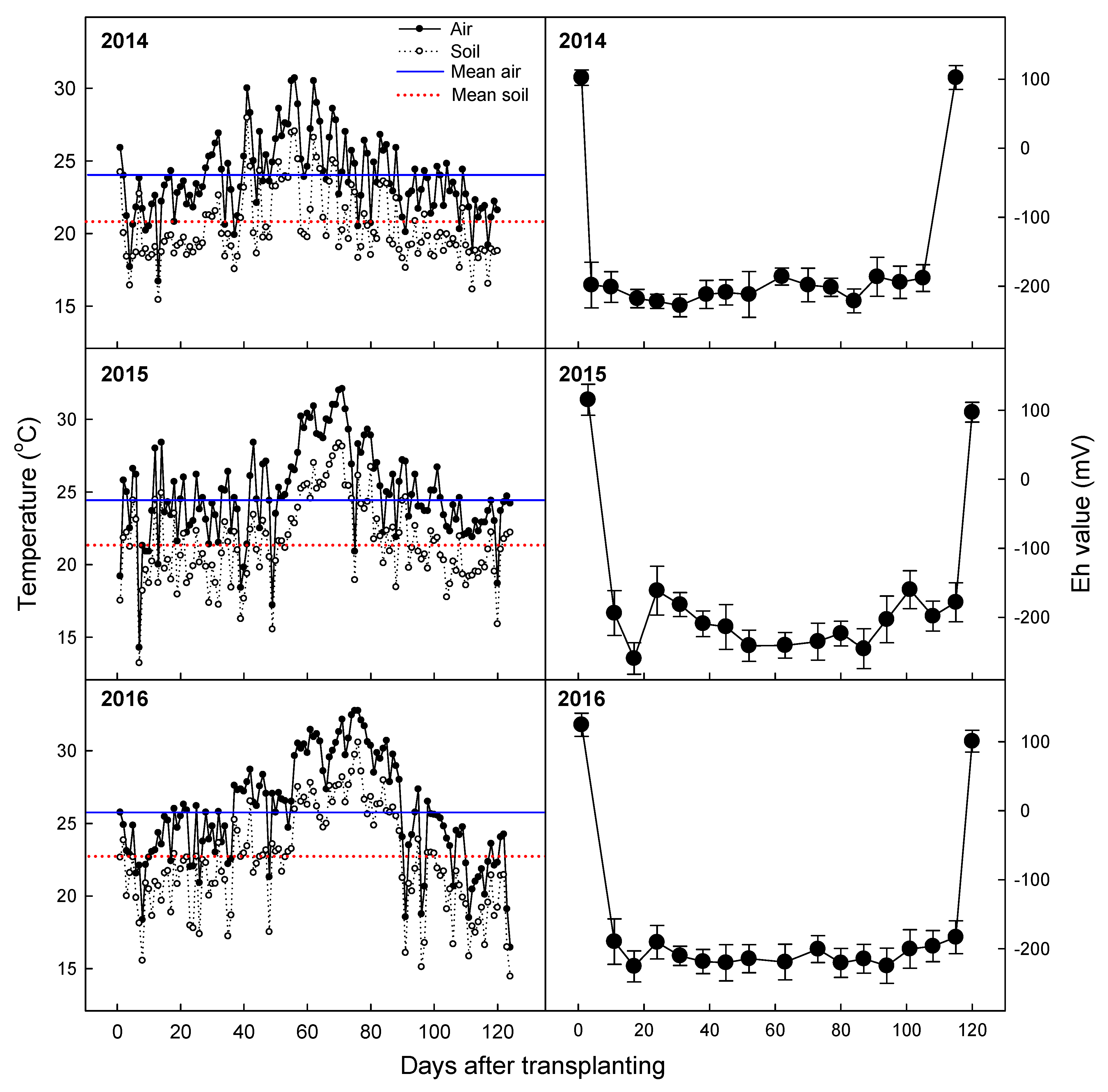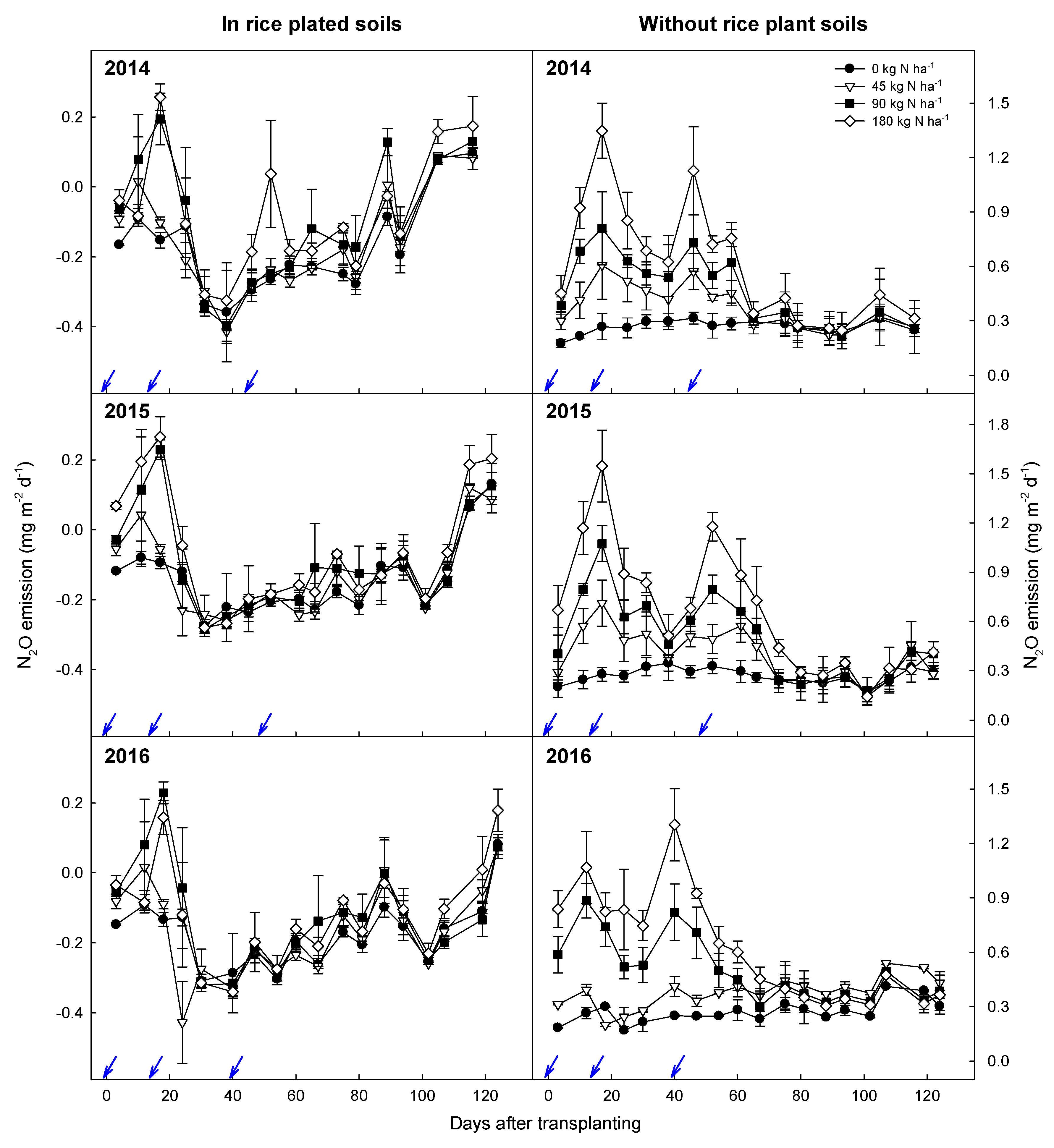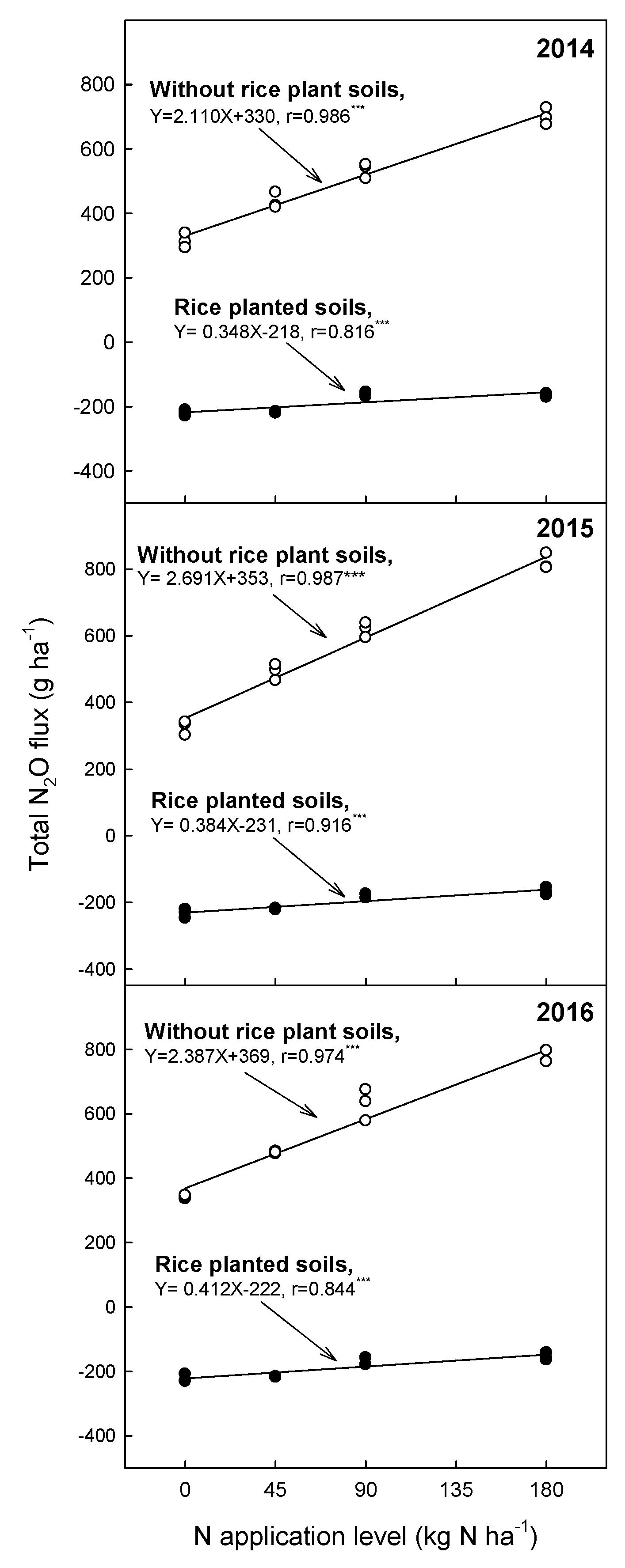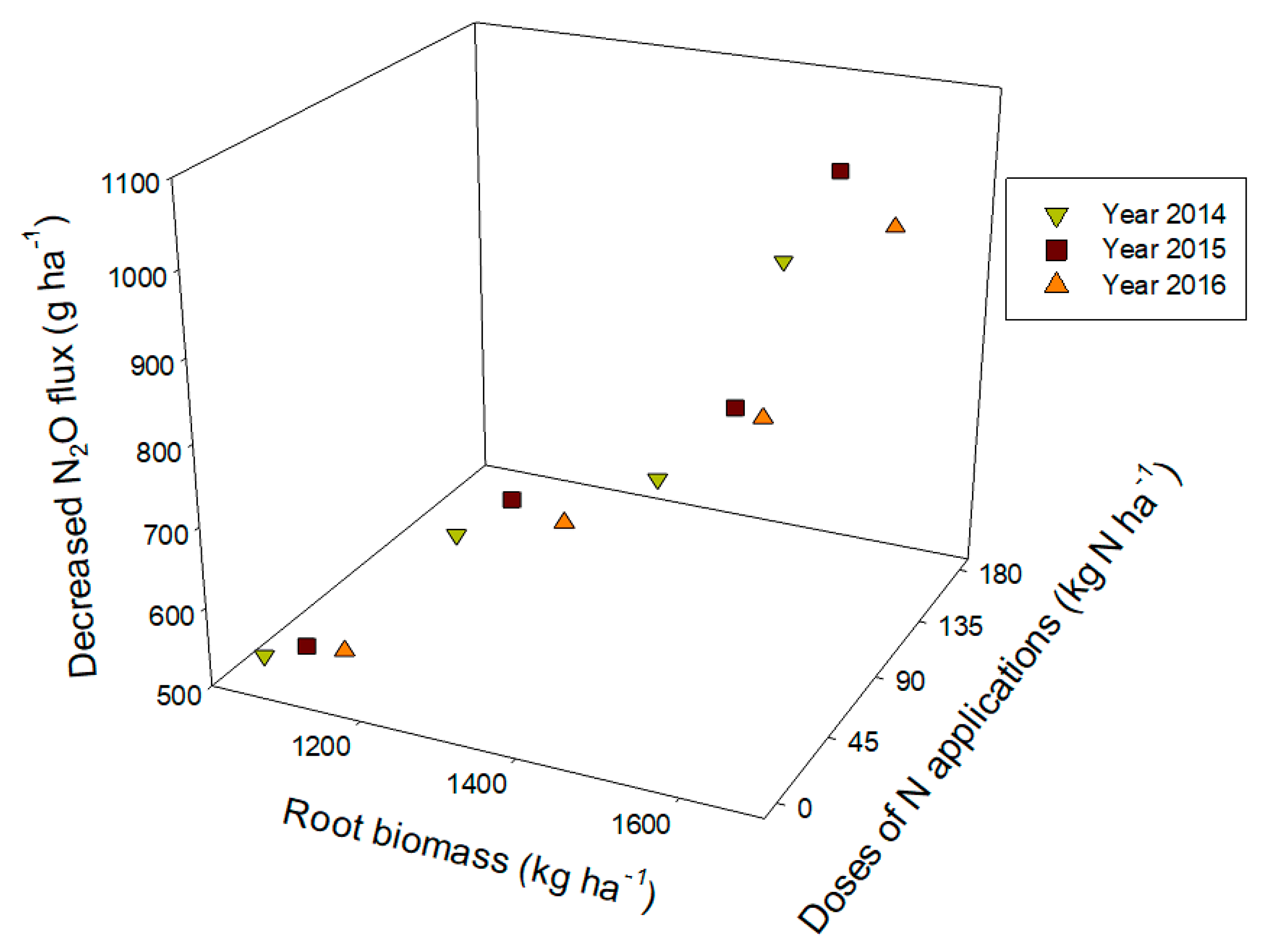Effect of Rice Planting on Nitrous Oxide (N2O) Emission under Different Levels of Nitrogen Fertilization
Abstract
1. Introduction
2. Materials and Methods
2.1. Preparation of Experimental Field for Rice Transplanting
2.2. Gas Sample Correcting and Analysis
2.3. Calculation of N2O Fluxes
2.4. Analysis of Air Temperature, Soil and Rice Yield Properties
2.5. Statistical Analysis
3. Results
3.1. Changes of Soil Temperature and Eh Value during Rice Cultivation
3.2. Rice yield Properties
3.3. Changes of N2O Emission Rates
3.4. Changes of Seasonal N2O Fluxes
4. Discussion
5. Conclusions
Supplementary Materials
Author Contributions
Funding
Institutional Review Board Statement
Informed Consent Statement
Data Availability Statement
Acknowledgments
Conflicts of Interest
References
- IPCC. Climate Change 2007: Mitigation of Climate Change—Contribution of Working Group III to the Fourth Assessment Report of the Intergovernmental Panel on Climate Change; Cambridge University Press: Cambridge, UK, 2007. [Google Scholar]
- Ravishankara, A.; Daniel, J.S.; Portmann, R.W. Nitrous oxide (N2O): The dominant ozone-depleting substance emitted in the 21st century. Science 2009, 326, 123–125. [Google Scholar] [CrossRef] [PubMed]
- World Meteorological Organization. Current extreme weather events. In Weather Extremes in a Changing Climate: Hindsight on Foresight; World Meteorological Organization: Geneva, Switzerland, 2010; Available online: http://www.wmo.int/pages/mediacentre/news/extremeweathersequence_2010_en.html (accessed on 5 October 2011).
- Bouwman, A.; Boumans, L.; Batjes, N. Emissions of N2O and NO from fertilized fields: Summary of available measurement data. Glob. Biogeochem. Cycles 2002, 16, 6-1–6-13. [Google Scholar] [CrossRef]
- Smith, P.; Martino, Z.; Cai, D. Agriculture. In Climate Change 2007: Mitigation; IPCC: Geneve, Switzerland, 2007. [Google Scholar]
- Syakila, A.; Kroeze, C. The global nitrous oxide budget revisited. Greenh. Gas Meas. Manag. 2011, 1, 17–26. [Google Scholar] [CrossRef]
- Sutton, M.A.; Nemitz, E.; Erisman, J.W.; Beier, C.; Bahl, K.B.; Cellier, P.; de Vries, W.; Cotrufo, F.; Skiba, U.; di Marco, C.; et al. Challenges in quantifying biosphere–atmosphere exchange of nitrogen species. Environ. Pollut. 2007, 150, 125–139. [Google Scholar] [CrossRef] [PubMed]
- Nayak, D.; Babu, Y.J.; Datta, A.; Adhya, T. Methane oxidation in an intensively cropped tropical rice field soil under long-term application of organic and mineral fertilizers. J. Environ. Qual. 2007, 36, 1577–1584. [Google Scholar] [CrossRef]
- Stehfest, E.; Bouwman, L. N2O and NO emission from agricultural fields and soils under natural vegetation: Summarizing available measurement data and modeling of global annual emissions. Nutr. Cycl. Agroecosyst. 2006, 74, 207–228. [Google Scholar] [CrossRef]
- Venterea, R.T.; Bijesh, M.; Dolan, M.S. Fertilizer source and tillage effects on yield-scaled nitrous oxide emissions in a corn cropping system. J. Environ. Qual. 2011, 40, 1521–1531. [Google Scholar] [CrossRef]
- Birla, D.S.; Malik, K.; Sainger, M.; Chaudhary, D.; Jaiwal, R.; Jaiwal, P.K. Progress and challenges in improving the nutritional quality of rice (Oryza sativa L.). Crit. Rev. Food Sci. Nutr. 2017, 57, 2455–2481. [Google Scholar] [CrossRef]
- Rejesus, R.M.; Mohanty, S.; Balagtas, J.V. Forecasting global rice consumption, Department of Agricultural and Resource Economics, North Carolina State University. Crit. Rev. Food Sci. Nutr. 2012, 57, 2455–2481. [Google Scholar]
- Mosier, A.R.; Bleken, M.A.; Chaiwanakupt, P.; Ellis, E.C.; Freney, J.R.; Howarth, R.B.; Matson, P.A.; Minami, K.; Naylor, R.; Weeks, K.N.; et al. Policy implications of human-accelerated nitrogen cycling. In The Nitrogen Cycle at Regional to Global Scales; Springer: Berlin/Heidelberg, Germany, 2002; pp. 477–516. [Google Scholar]
- Dobermann, A.; Cassman, K.G. Cereal area and nitrogen use efficiency are drivers of future nitrogen fertilizer consumption. Sci. China Ser. C Life Sci. 2005, 48, 745–758. [Google Scholar]
- Jørgensen, C.J.; Struwe, S.; Elberling, B. Temporal trends in N2O flux dynamics in a Danish wetland–effects of plant-mediated gas transport of N2O and O2 following changes in water level and soil mineral-N availability. Glob. Chang. Biol. 2012, 18, 210–222. [Google Scholar] [CrossRef]
- Yu, K.; Chen, G. Nitrous Oxide Emissions from Terrestrial Plants: Observations, Mechanisms and Implications. In Nitrous Oxide Emissions Research Progress; Nova Science Publishers: Hauppauge, NY, USA, 2009; pp. 85–104. [Google Scholar]
- de Klein, C.A.; Barton, L.; Sherlock, R.R.; Li, Z.; Littlejohn, R.P. Estimating a nitrous oxide emission factor for animal urine from some New Zealand pastoral soils. Soil Res. 2003, 41, 381–399. [Google Scholar] [CrossRef]
- Luo, J.; Lindsey, S.; Ledgard, S. Nitrous oxide emissions from animal urine application on a New Zealand pasture. Biol. Fertil. Soils 2008, 44, 463–470. [Google Scholar] [CrossRef]
- Kallenbach, C.M.; Rolston, D.E.; Horwath, W.R. Cover cropping affects soil N2O and CO2 emissions differently depending on type of irrigation. Agric. Ecosyst. Environ. 2010, 137, 251–260. [Google Scholar] [CrossRef]
- Peyrard, C.; Mary, B.; Perrin, P.; Véricel, G.; Gréhan, E.; Justes, E.; Léonard, J. N2O emissions of low input cropping systems as affected by legume and cover crops use. Agric. Ecosyst. Environ. 2016, 224, 145–156. [Google Scholar] [CrossRef]
- Zhang, A.; Cui, L.; Pan, G.; Li, L.; Hussain, Q.; Zhang, X.; Zheng, J.; Crowley, D. Effect of biochar amendment on yield and methane and nitrous oxide emissions from a rice paddy from Tai Lake plain, China. Agric. Ecosyst. Environ. 2010, 139, 469–475. [Google Scholar] [CrossRef]
- Hopkins, W.; Hüner, N. Acclimation to environmental stress. In Introduction to Plant Physiology; John Wiley and Sons: Hoboken, NJ, USA, 2009; pp. 241–260. [Google Scholar]
- RDA. Fertilization Standards to Crop Plants; National Institute of Agricultural Science and Technology, RDA: Suwon, Korea, 1999; p. 148. (In Korean) [Google Scholar]
- RDA. Standard Investigation Methods for Agriculture Experiment; National Institute of Agricultural Science and Technology, RDA: Suwon, Korea, 1995; p. 601. (In Korean) [Google Scholar]
- Rolston, D.E. Gas flux. In Methods of Soil Analysis, 2nd ed.; Klute, A., Ed.; ASA and SSSA: Dadisom, WI, USA, 1986; pp. 1103–1119. [Google Scholar]
- Lou, Y.; Li, Z.; Zhang, T.; Liang, Y. CO2 emissions from subtropical arable soils of China. Soil Biol. Biochem. 2004, 36, 1835–1842. [Google Scholar] [CrossRef]
- Singh, S.; Singh, J.; Kashyap, A. Methane flux from irrigated rice fields in relation to crop growth and N-fertilization. Soil Biol. Biochem. 1999, 31, 1219–1228. [Google Scholar] [CrossRef]
- Huang, Y.; Zhang, W.; Sun, W.; Zheng, X. Net primary production of Chinese croplands from 1950 to 1999. Ecol. Appl. 2007, 17, 692–701. [Google Scholar] [CrossRef]
- Butterbach-bahl, K.; Baggs, E.M.; Dannenmann, M.; Kiese, R.; Zechmeisterboltenstern, S. Nitrous oxide emissions from soils: How well do we understand the processes and their controls? Philos. Trans. R. Soc. 2013, 368, 91–97. [Google Scholar] [CrossRef]
- Ma, S.; Shan, J.; Yan, X.Y. N2O emissions dominated by fungi in an intensively managed vegetable field converted from wheat–rice rotation. Appl. Soil Ecol. 2017, 116, 23–29. [Google Scholar] [CrossRef]
- Zhang, J.B.; Müller, C.; Cai, Z.C. Heterotrophic nitrification of organic N and its contribution to nitrous oxide emissions in soils. Soil Biol. Biochem. 2015, 84, 199–209. [Google Scholar] [CrossRef]
- Sey, B.K.; Manceur, A.M.; Whalen, J.K.; Gregorich, E.G.; Rochette, P. Small-scale heterogeneity in carbon dioxide, nitrous oxide and methane production from aggregates of a cultivated sandy-loam soil. Soil Biol. Biochem. 2008, 40, 2468–2473. [Google Scholar] [CrossRef]
- Verchot, L.; Hutabarat, L.; Hairiah, K.; van Noordwijk, M. Nitrogen availability and soil N2O emissions following conversion of forests to coffee in southern Sumatra. Glob. Biogeochem. Cycles 2006, 20, GB4008. [Google Scholar] [CrossRef]
- Paul, E.A. Soil Microbiology, Ecology and Biochemistry; Academic Press: Cambridge, MA, USA, 2014. [Google Scholar]
- IPCC. Chapter 11.2: N2O emissions from managed soils, Intergovernmental Panel on Climate Change. In 2006 IPCC Guidelines for National Greenhouse Gas Inventories; IPCC: Geneve, Switzerland, 2006. [Google Scholar]
- Hou, A.; Chen, G.; Wang, Z.; Van Cleemput, O.; Patrick, W., Jr. Methane and nitrous oxide emissions from a rice field in relation to soil redox and microbiological processes. Soil Sci. 2000, 64, 2180–2186. [Google Scholar] [CrossRef]
- Wang, Y.; Hu, C.; Zhu, B.; Xiang, H.; He, X. Effects of wheat straw application on methane and nitrous oxide emissions from purplish paddy fields. Plant Cell Environ. 2010, 56, 16–22. [Google Scholar] [CrossRef]
- Yu, K.; Patrick, W.H. Redox window with minimum global warming potential contribution from rice soils. Soil Sci. Soc. Am. J. 2004, 68, 2086–2091. [Google Scholar] [CrossRef]
- Van Groenigen, J.; Velthof, G.; Oenema, O.; Van Groenigen, K.; Van Kessel, C. Towards an agronomic assessment of N2O emissions: A case study for arable crops. Eur. J. Soil Sci. 2010, 61, 903–913. [Google Scholar] [CrossRef]
- Smart, D.R.; Bloom, A.J. Wheat leaves emit nitrous oxide during nitrate assimilation. Proc. Natl. Acad. Sci. USA 2001, 98, 7875–7878. [Google Scholar] [CrossRef]
- Colmer, T.D. Long-distance transport of gases in plants: A perspective on internal aeration and radial oxygen loss from roots. Plant Cell Environ. 2003, 26, 17–36. [Google Scholar] [CrossRef]
- Gutierrez, J.; Atulba, S.L.; Kim, G.; Kim, P.J. Importance of rice root oxidation potential as a regulator of CH4 production under waterlogged conditions. Biol. Fertil. Soils 2014, 50, 861–868. [Google Scholar] [CrossRef]




| Year | N Levels (kg N ha−1) | Yield (Mg ha−1) | Straw (Mg ha−1) | Root (Mg ha−1) | Height (cm) | Tiller Number Per Hill |
|---|---|---|---|---|---|---|
| 2014 | 0 | 4.60 ± 0.51 b a | 5.93 ± 0.19 c | 1.05 ± 0.05 c | 87 ± 0.9 d | 11 ± 0.3 c |
| 45 | 5.21 ± 0.27 ab | 7.07 ± 0.14 b | 1.23 ± 0.03 b | 94 ± 0.6 c | 14 ± 1.2 b | |
| 90 | 5.90 ± 0.05 a | 8.26 ± 0.49 a | 1.42 ± 0.05 a | 105 ± 0.8 b | 14 ± 1.0 b | |
| 180 | 5.41 ± 0.33 ab | 9.06 ± 0.31 a | 1.45 ± 0.01 a | 108 ± 0.6 a | 18 ± 0.4 a | |
| 2015 | 0 | 4.98 ± 0.23 b | 6.14 ± 0.18 c | 1.11 ± 0.03 c | 92 ± 0.6 c | 12 ± 0.7 b |
| 45 | 5.42 ± 0.99 ab | 7.30 ± 0.12 b | 1.30 ± 0.10 b | 96 ± 0.9 b | 15 ± 1.0 ab | |
| 90 | 6.74 ± 0.24 a | 8.39 ± 0.26 b | 1.51 ± 0.05 a | 97 ± 0.9 b | 16 ± 16.1 a | |
| 180 | 5.84 ± 0.39 ab | 9.32 ± 0.55 a | 1.52 ± 0.04 a | 104 ± 1.2 a | 17 ± 1.4 a | |
| 2016 | 0 | 5.31 ± 0.39 b | 6.32 ± 0.38 c | 1.16 ± 0.01 b | 95 ± 2.4 b | 11 ± 0.5 b |
| 45 | 6.03 ± 0.43 ab | 7.66 ± 0.14 b | 1.37 ± 0.03 ab | 96 ± 2.0 b | 13 ± 2.9 ab | |
| 90 | 6.92 ± 1.12 a | 8.56 ± 0.45 b | 1.55 ± 0.09 a | 98 ± 2.7 b | 14 ± 2.9 ab | |
| 180 | 6.32 ± 1.71 ab | 9.58 ± 0.42 a | 1.59 ± 0.20 a | 107 ± 1.1 a | 17 ± 0.42 a | |
| Statistical analysis b | ||||||
| Year (A) | * | ** | NS | ** | NS | |
| N application (B) | ** | *** | *** | *** | *** | |
| A × B | NS | NS | NS | *** | NS | |
| Properties | Year | ||
|---|---|---|---|
| 2014 | 2015 | 2016 | |
| Grain | 0.547 * | 0.482 | 0.351 |
| Straw | 0.899 *** | 0.946 *** | 0.984 *** |
| Root | 0.856 *** | 0.865 *** | 0.824 *** |
| Tiller number | 0.898 *** | 0.952 *** | 0.870 *** |
| Rice height | 0.937 *** | 0.850 *** | 0.787 ** |
Publisher’s Note: MDPI stays neutral with regard to jurisdictional claims in published maps and institutional affiliations. |
© 2021 by the authors. Licensee MDPI, Basel, Switzerland. This article is an open access article distributed under the terms and conditions of the Creative Commons Attribution (CC BY) license (http://creativecommons.org/licenses/by/4.0/).
Share and Cite
Kim, G.W.; Kim, P.J.; Khan, M.I.; Lee, S.-J. Effect of Rice Planting on Nitrous Oxide (N2O) Emission under Different Levels of Nitrogen Fertilization. Agronomy 2021, 11, 217. https://doi.org/10.3390/agronomy11020217
Kim GW, Kim PJ, Khan MI, Lee S-J. Effect of Rice Planting on Nitrous Oxide (N2O) Emission under Different Levels of Nitrogen Fertilization. Agronomy. 2021; 11(2):217. https://doi.org/10.3390/agronomy11020217
Chicago/Turabian StyleKim, Gil Won, Pil Joo Kim, Muhammad Israr Khan, and Sung-Jae Lee. 2021. "Effect of Rice Planting on Nitrous Oxide (N2O) Emission under Different Levels of Nitrogen Fertilization" Agronomy 11, no. 2: 217. https://doi.org/10.3390/agronomy11020217
APA StyleKim, G. W., Kim, P. J., Khan, M. I., & Lee, S.-J. (2021). Effect of Rice Planting on Nitrous Oxide (N2O) Emission under Different Levels of Nitrogen Fertilization. Agronomy, 11(2), 217. https://doi.org/10.3390/agronomy11020217








